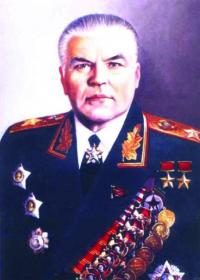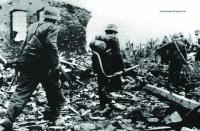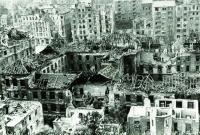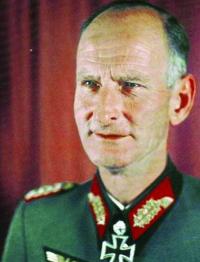THIS MONTH, seventy years ago, the Red Army and its new allies, the Royal Romanian Army and the Royal Bulgarian Army, began an offensive designed to capture the Hungarian capital of Budapest. The Hungarian city can trace its roots back 2,000 years and is actually two cities, Buda and Pest, located on opposite sides of the Danube River.
On October 30, 1944, the 2nd and 3rd Ukranian Fronts commanded by Marshals Rodion Malinovsky and Fyodor Ivanovitch Tolbukhin, together with the 1st and 4th Romanian Armies, commanded by Nicolae Macici and Gheorghe Avramescu, and the 1st Bulgarian Army, commanded by Vladimir Stoychev, totaling 1,000,000 soldiers, commenced the Budapest Strategic Offensive Operation. It was an attempt to capture the Hungarian capital. By November 2, it had resulted in the capture of the southern suburbs of Alag and Kisalag. That initial effort ceased on November 24, 1944.
A renewed Soviet/ Romanian/ Bulgarian offensive was launched on December 3, 1944, and within six days, had reached the Danube River, north of the city. By Christmas the Hungarian capital was surrounded, trapping 190,000 German and Hungarian troops. The new Hungarian Nemzetvezetō (National Leader), Ferenc Szálasi, escaped from his nation’s capital on December 9, 1944. The 800,000 civilians remaining in the city continued their daily lives - seemingly oblivious to the fate awaiting them upon the arrival of the Red Army. Although they felt that the city would fall to the Red Army, the feeling was that the city’s, “...inhabitants will face marshals, while in the villages, corporals will govern.” And, the Red Army had yet to acquire its reputation for the rape of its enemies’ women.
After the city was surrounded, SS-Gruppenführer & Generalleutnant der Waffen-SS Karl von Pfeffer-Wildenbruch was placed in charge of the city’s defenses. He established his command center on Castle Hill, in the center of the Hungarian Government district.
General von Pfeffer-Wildenbruch had been commander of the IX SS Mountain Corps, which was, stationed in Budapest. The Corps consisted of the following: SS Florian Geyer Cavalry Division commanded by Joachim Rumohr; SS María Theresa Cavalry Division, commanded by August Zehender: the Feldherrnhalle Panzer-Grenadier Division, commanded by Günther Pape until November 27, 1944, and then by Afrika Korps veteran, Ulrich Kleemann: and the Feldherrnhalle Panzer Division, commanded by Gerhard Schmidhuber. General von Pfeffer-Wildenbruch’s command also included the Hungarian I Corps, commanded by General Vitéz (Count) Iván von Hindy de Kishind. Vitéz von Hindy’s I Corps consisted of the First Armored and the 10th Infantry & 12th Scythian Divisions.
The Florian Geyer was named for a German knight who was a follower of Martin Luther and sided, and fought, with the peasants against the nobility and Catholic Church during the “Peasant’s War” of 1522-1525. The division’s soldiers were Romanians and Serbs of German origin.
The SS María Theresa Cavalry Division, was named for María Theresa, an 18th century Austrian Empress. Since her favorite flower was the cornflower, that became the division’s insignia. The division’s soldiers were Hungarians of German, or Austrian, origin.
The Feldherrnhalle divisions were comprised of members of the SA, and were named for the building in Munich where the Nazi Party met.
By December 27, Budapest had been surrounded, and its main airport lost, causing der Führer to relieve Generals Johannes Frießner and Maximilian Fretter-Pico of command of Army Group South and Sixth Army, respectively. They were replaced by Generals Otto Wöhler and Hermann Balck.
On December 28, 1944, the Soviets contacted the Germans by loud speaker proposing negotiations for the city’s capitulation. They told the Germans that their emissaries would not bring weapons and would appear in cars with white flags the next day. After their proposals had been rejected by General von Pfeffer-Wildenbruch and the Soviets began the trek back to their lines, the Germans opened fire, killing most.
A relief effort was launched on January 1, 1945 - Operation Konrad - led by IV SS Panzerkorps, commanded by SS-Obergruppenführer und General der Waffen-SS Herbert Otto Gille. Gille was the most highly decorated SS soldier in history. Gille’s corps included two of the best and toughest divisions of the war - SS Totenkopf Panzer Division, commanded by Hellmuth Becker and the SS Viking Panzer Division, commanded by Karl Ulrich - and the 96th and 711 Infantry Divisions, commanded by Generals Hermann Harrendorf and Reichert. General Gille broadcast to the garrison, “Hang on! We’re coming!” The Soviets broadcast, “Gille’s coming, but we’re going to kill him!” After three days, and the Panzerkorps being only 20 miles from Budapest, the effort was ceased. It had cost 2,938 men. It had destroyed, or captured, 160 guns, 107 antitank guns and 79 tanks.
The Totenkopf Division was formed, initially from concentration camp guards, by its original commander Theodore Eiche. The name means “Death’s Head” in German. The Viking Division was a true international, volunteer division, being composed of Estonians, Belgians, Danes, Swedes and Germans. Both divisions only fought on the Eastern Front.
On January 7, a second relief operation - Operation Konrad II - began, which reached a point 15 miles from Budapest. They were so close that the Panzer-Grenadiers could see the church spires and turrets, but this effort was, inexplicably, canceled.
The last attempt to relieve the encircled Hungarian capital - Operation Konrad III - was launched on January 20, 1945, by the III Panzerkorps, commanded by Hermann A. Breith, and General Gille’s IV SS Panzerkorps. By January 28, that effort had also been stopped. The Viking and Totenkopf Divisions suffered 8,000 casualties in these failed relief efforts.
On January 17, all remaining Axis troops withdrew from Pest to Buda on the other side of the Danube River. Over the protests of their Hungarian allies, all five of the beautiful bridges over the river were destroyed by the Germans. That same day, Swedish diplomat/businessman Raoul Wallenberg was summoned to Marshal Malinovsky’s headquarters. Upon his departure, he said, “I’m going to Malinovsky’s - whether as a guest or as a prisoner, I do not know, yet.” Unfortunately, it was the latter. The order to arrest him came from Deputy Commissar for Defense, Nikolai Bulganin.
Sweden had agreed to assign Wallenberg to its legation in Budapest, if the Americans would lighten the pressure on Sweden because of its trading relationship with the German Reich. His mission was to do what he could to save as many Jews from the German charnel as possible. In this, he had considerable success, by printing passports, visas and other documents and renting buildings in Budapest which he then proclaimed as part of the Swedish Embassy. Jews were then housed in these buildings, which were adorned with Swedish flags and an important sounding name, such as “The Swedish Research Institute.” Negotiations were undertaken between German and Hungarian authorities and Wallenberg for the lives of the Jews. Bribes were paid. Wallenberg is credited with saving thousands of Jews, including the late Representative Tom Lantos from California. For his tireless and death-defying work, he was named “Righteous Among the Nations,” and his name inscribed upon the Wall of Honor in the Garden of the Righteous at Yad Vashem in Jerusalem. He was murdered while in Soviet custody. The details of how, when, why and by whom, remain unknown. His memory lives in monuments, street, school, park and building names around the world.
On February 11, 1945, after six weeks of fighting, Gellért Hill fell to the Soviets after they launched a heavy attack from three different directions simultaneously. Once Gellért Hill, which dominated the city, fell, the end was in sight. From there Soviet artillery was able to dominate the entire city. By now, the Axis forces were no longer able to receive supplies which had been flown in and landed by gliders on the streets.
That day, taking advantage of heavy fog, some 28,000 Axis troops, together with unnumbered civilians, attempted a breakout in three waves. The first wave, taking advantage of the element of surprise, had some success, although most were killed or captured. Generals Zehender and Schmidhuber were among those killed. General Rumohr was wounded and committed suicide.
The remainder of the city’s defenders surrendered on February 13, 1945. The capture of Budapest had cost the Red and Romanian Armies between 80,000 dead and 240,000 wounded. The Axis forces suffered 40,000 dead and 62,000 wounded. More than 80 percent of the city was destroyed or damaged and more than 38,000 civilians died during the siege, 15,000 of whom were Jews executed by the Hungarian Arrow Cross Party.
Estimates of the number of rapes committed by the Red and Romanian Armies in Budapest, after its fall, range from 5,000 to 200,000, with most estimates at 50,000 - 70,000. The Swiss Embassy reported that rapes of women between the ages of 10 - 70, “ . . . are so common, that very few women in Hungary have been spared.”
NEXT: BATTLE OF THE BULGE
Mr. Wimbrow writes from Ocean City, Maryland, where he practices law representing those persons accused of criminal and traffic offenses, and those persons who have suffered a personal injury through no fault of their own. Mr. Wimbrow can be contacted at
wimbrowlaw@gmail.com.






